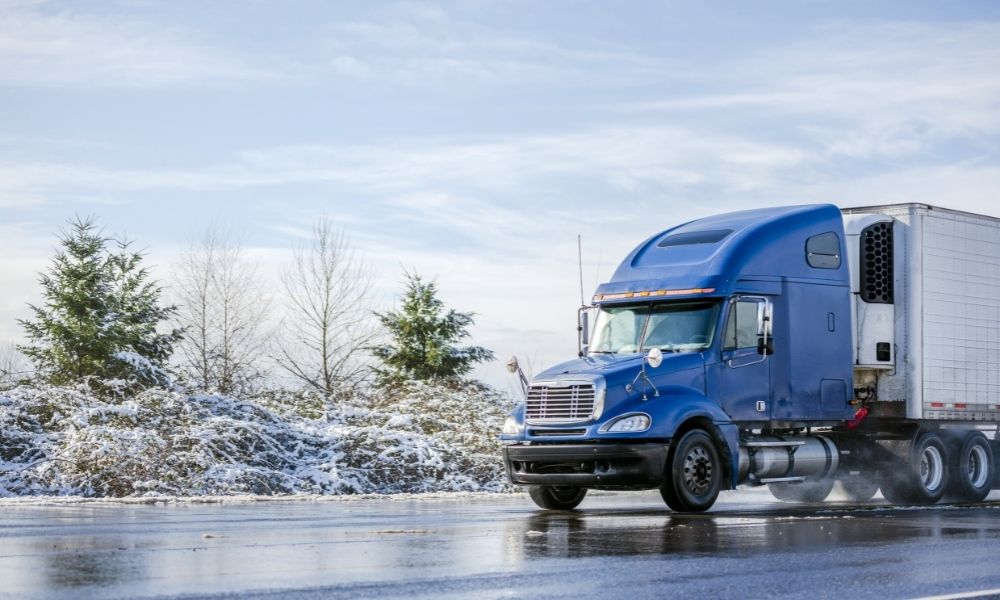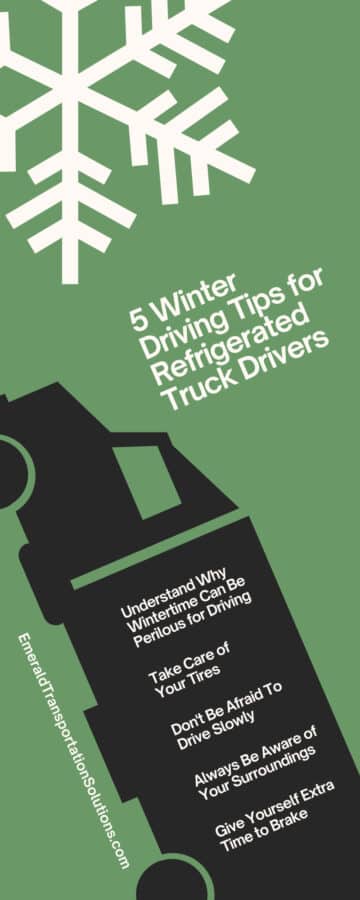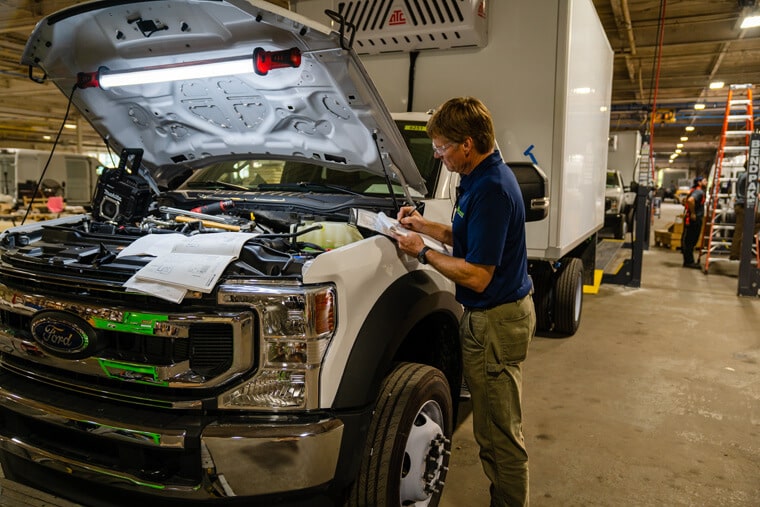
5 Winter Driving Tips for Refrigerated Truck Drivers
Joe Dickman | February 4th, 2022
The colder months can present significant challenges for refrigerated trucks as they make their deliveries. As drivers navigate slick roads and difficult-to-see conditions, safety should be your top priority, whether you’re the one behind the wheel or managing other employees who will be. Continue reading to explore five winter driving tips for refrigerated truck drivers that can help keep you safe on the road.
Understand Why Wintertime Can Be Perilous for Driving
Even the most experienced truck drivers face numerous challenges when the weather becomes colder since extreme weather can affect anybody while driving. Adverse conditions have a considerable influence on your truck’s ability to stay steady, get adequate traction, prevent collisions, and maintain good visibility. Aside from the dangers to your safety, the icy air has a detrimental effect on your fuel economy, which you must account for.
Ice Is the Number One Hazard
Ice is the most dangerous winter weather danger since it is hard to discern and can cause your vehicle to completely lose control. Ice forms when the roadway gets saturated from rain, melting snow, or other water sources, causing the temperature on the road’s surface to drop below freezing. As it takes much longer for the surface to thaw, ice might linger on the roadway even when the temperature climbs above freezing.
Poor Visibility Is Also a Big Concern
While it is evident that a heavy blizzard or ice and snow building up on your windshield can create poor visibility, your line of sight can also get impaired on a chilly, calm evening. Condensation on the inside of your windshield can make it hard to see if your heater or rear window defroster isn’t working correctly. Before hitting the road in chilly weather, make sure these systems are in working order.
Be as Prepared as Possible
You can take general precautions to prepare for anything that might happen during winter. Keep basic supplies on hand, including charging equipment, a backup radio, batteries, warm gloves, a first aid kit, extra food and water, and an additional jacket in case of a breakdown.
You should also have handy items such as windshield scrapers, spare blades, washer fluid, tire chains, and jumper cables with you at all times in case your truck experiences issues. Finally, always try to keep your gas tank filled (no less than half a tank before you begin) to prevent the gas line from freezing.
Take Care of Your Tires
Your tires play a crucial role in keeping you safe and achieving good fuel efficiency. Inspect your tires regularly for even traction and to ensure that there’s no damage from road debris.
Watch for Low Pressure
Cooler air reduces tire air pressure, so even if you’ve correctly inflated your tires during warmer weather, there’s a strong possibility you don’t have enough PSI during the winter. In addition to looking for damage, you should regularly ensure that you appropriately fill your tires to the correct PSI.
Check for Worn-Down Treads
While truck drivers who undergo frequent inspections have a lower risk of having worn-down or bald tires, it’s still a danger you should be aware of. If you notice excessive wear and tear on your treads, communicate with your dispatcher and fleet supervisor right away. If you live in a location that receives a lot of snow, you should consider getting snow tires.
Don’t Be Afraid To Drive Slowly
Winter weather is to blame for many accidents and fatalities, and you don’t want to be one of them. Even if you are pressed for time when making a delivery, unloading on schedule is never more important than your safety. When dealing with severe weather such as heavy snowfall and icy roads, drive cautiously, even if it means going a little slower than the posted speed limit.
Plan Ahead
If you know you’ll be dealing with heavy snow and other winter conditions, you should plan your trip accordingly. Allow for more time than you think you’ll need to account for weather-related delays and the need to go slower than usual. Slower speeds will enable you and your fellow drivers to remain safe on the road.
Always Be Aware of Your Surroundings
It’s easy to become complacent as you travel the same path a thousand times, but the winter season brings hazards that compel you to be extra cautious. Icy rain, slippery roads, heavy snowfall, and temperature changes can swiftly alter the landscape of any road.
That’s why it’s critical to keep an eye out for any sudden changes in road conditions and to keep your head on a swivel. You should always keep your eyes on the road so you can react accordingly to other cars or any potential unexpected events.
Special Conditions To Look Out For
During the winter, the jet stream shifts south, causing winds aloft to increase significantly and requiring you to adjust your steering when you meet strong gusts. You’ll also want to take extra precautions and drive slowly as soon as you reach bridges, as these structures are always the first to ice over. Finally, black ice can also be harder to identify since it looks like wet pavement; therefore, drive extra cautiously when the temperature is at or below freezing.
Give Yourself Extra Time to Brake
Widen the gap between your truck and other motorists in front and behind you when driving during inclement weather. Your average braking distance should rise by 8-10 seconds on icy, snowy, or slippery road surfaces. That extra amount of space could be the difference between causing a pileup and stopping just in time before a severe accident occurs.
Pay Special Attention to Stops in the Road
You’ll want to allow yourself plenty of time to brake as you approach intersections or red lights. The more time and space you give yourself to stop, the less likely you are to slip off the road or collide with cars that may have difficulty stopping themselves.
When you follow these five winter driving tips for refrigerated truck drivers, you can keep yourself, your vehicle, and your cargo safe until you make your deliveries. Emerald Transportation Solutions offers refrigerated trucks for sale that make fantastic additions to your delivery fleet no matter what the temperature outside is like. Feel free to contact us with any questions about our vehicles.
Related Articles
Contact Us
Feel Free To Contact Us If You Have Any Questions
What does under DOT mean?
Questions regarding DOT requirements come up often. 10,000 lbs GVW (gross vehicle weight) and over are commercial vehicles that fall under the Department of Transportation regulatory requirements.
What is the difference between GVW and payload?
GVW or Gross Vehicle Weight is the entire weight of the vehicle including the payload. The payload weight represents the amount of cargo you are hauling.
What is a self-powered unit and a vehicle-powered unit?
A self-powered unit has its own fuel source and will run independent of the truck. This is the heaviest and most expensive option. While vehicle-powered units run off the engine via a compressor mounted on the engine. These are less expensive and lighter in weight but you must run the truck or plug the electric standby into shore power.
What does K-factor mean and why is that important?
K-factor is a term that stands for the overall insulating value of the container (truck body). Quite simply the lower the K-factor the better the truck body will be able to maintain a given temperature and require less energy to do so.
How much lighter is a Poly Van vs a US spec body?
Poly Van bodies are very light. On average we estimate we are 75-150 lbs per foot lighter than a traditional sheet and post foamed in place body. These weight savings translates to less fuel burn and less CO2 emissions, along with added payload, the most important benefit.







